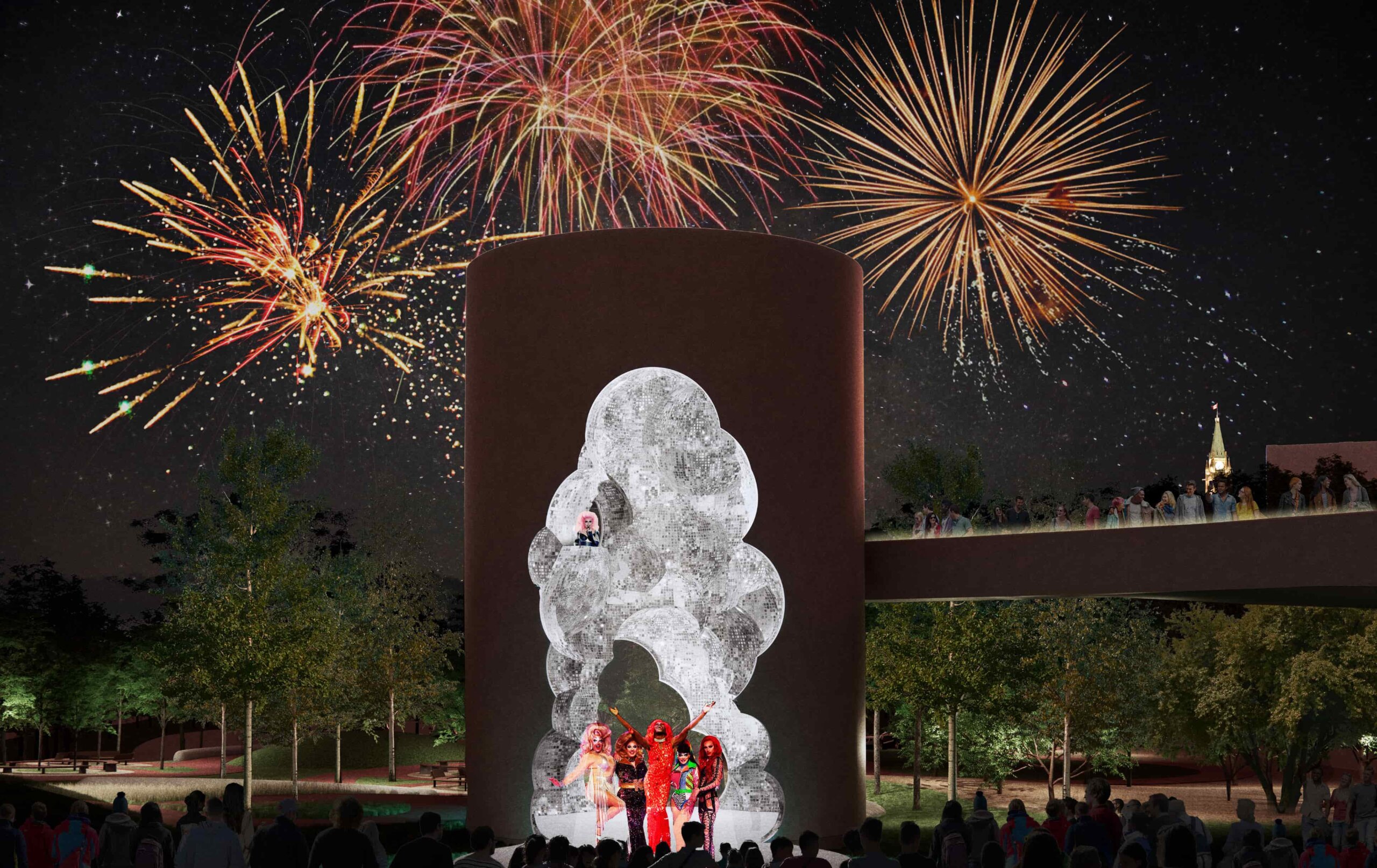The winning design for Canada’s LGBTQ2S+ National Monument was unveiled on Thursday at a joint press conference held by representatives of the LGBT Purge Fund, the federal government and the monument’s design team. The LGBT Purge Fund was established in 2018 to manage monies from a class-action lawsuit brought forward by former Canadian Armed Forces personnel, RCMP officers and federal civil servants who had been fired from their jobs for being LGBTQ2S+.
The monument will be built in downtown Ottawa in honour of thousands of queer and trans individuals who were targeted by the federal government during the 1950s to 1990s in what has come to be known as the “LGBT Purge.”
The winning design, Thunderhead, was created by Winnipeg-based Team Wreford and chosen from a shortlist of five designs. The monument will consist of a 30 foot-tall cylinder, with the imprint of a thundercloud hollowed out of its centre. The interior will be lined with thousands of mirrored tiles, evoking Studio 54 disco balls while reflecting and refracting light.
“All of the other national monuments in Ottawa should be 10 percent queer, but they’re not. We want to create one that is 110 percent queer, 110 percent ours,” said lesbian visual artist Shawna Dempsey, a member of the monument’s winning design team, at this week’s press conference.
Dempsey’s frequent collaborator, Lorri Millan, was also on the team, as were Liz Wreford, Peter Sampson and Taylor LaRocque of Public City landscape architectural firm and Indigenous and Two-Spirit advisor Albert McLeod.

Credit: Courtesy of Team Wreford
The process of developing the monument started in late 2020, when the LGBT Purge Fund put out a call for monument designs and received 35 submissions. That was narrowed down to five shortlisted teams from around the world in early 2021; a survey was conducted in November 2021 to incorporate public feedback before the final design was selected by a 10-person jury that included survivors of the LGBTQ2S+ purge.
As the result of a class-action lawsuit settled in 2018, the federal government compensated 718 purge victims and pledged to set aside funds for reconciliation and memorialization projects. The LGBT Purge Fund has earmarked an estimated $8 million for the upcoming monument. Construction is slated to begin soon and last until 2025.
In an interview with Xtra, architect Peter Sampson says the design team had trusted its LGBTQ2S+ members with the core design elements. “We handed them the keys to the car and said, ‘Take us where we should be going,’” he says.
The thundercloud motif was originally created by Millan. The team agreed that its multiple interpretations reflected the many meanings they wanted the monument to convey: turbulence and volatile energy but also renewal, cleansing and cathartic celebration.
“It was a hard thing to find because it had to be something that represented joy, pain and happiness but also despair,” Wreford, a landscape architect, tells Xtra.
The monument site will also include a lush park with a garden, a stage and a fruit orchard. The latter is both a nod to the pejorative term “fruit” used to refer to LGBTQ2S+ people and a reference to the “fruit machine” of the 1950s and 1960s—a device that measured pupil dilation in response to pornographic images to supposedly identify homosexuals. The fruit machine gave its name to a landmark 2018 documentary about the LGBTQ2S+ purge.
There will also be a healing circle surrounded by 13 stones picked by Two-Spirit Elders, with one from each province and territory.

Credit: Courtesy of Team Wreford
McLeod, a Two-Spirit advocate who has ancestry from Nisichawayasihk Cree Nation and the Métis communities of Norway House and Cross Lake, noted that the Two-Spirit community endured the combined forces of colonialism, racism and anti-LGBTQ2S+ discrimination throughout the purge and beyond.
“Being Indigenous culturally was something that was attempted to be erased, and also being LGBT was something that was really devalued,” McLeod tells Xtra. “There was really an attempted erasure of historical knowledge about Two-Spirit people and our rightful place in society.”
While the federal government’s 2017 apology for the LGBTQ2S+ purge was a step in the right direction, many people who it affected directly did not live to see it. The National LGBTQ2S+ Monument is, therefore, a memorial as well.
“For those purge survivors who are no longer with us, it is a form of homage to them, to their spirits, and its vibrancy and its strength,” McLeod says. “The state tried to crush it but didn’t succeed. I think really, that is the legacy of this monument. They did not succeed.”


 Why you can trust Xtra
Why you can trust Xtra


